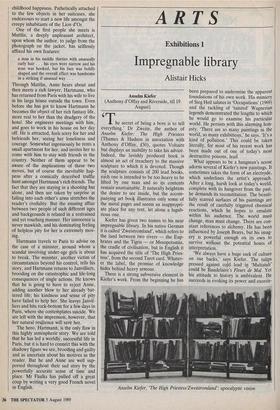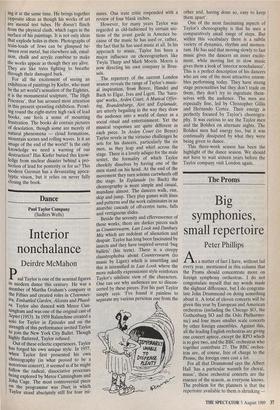ARTS
Exhibitions 1
Impregnable library
Alistair Hicks
Anselm Kiefer (Anthony d'Offay and Riverside, till 19 August) The secret of being a bore is to tell everything.' Dr Zweite, the author of Anselm Kiefer: The High Priestess (Thames & Hudson in association with Anthony d'Offay, £50), quotes Voltaire but displays an inability to take his advice. Indeed, the lavishly produced book is almost an act of treachery to the massive sculpture to which it is devoted. Though the sculpture consists of 200 lead books, each one is intended to be too heavy to be lifted by one man and so its contents remain unattainable. It naturally heightens the desire to see inside, but the accom- Panying art book illustrates only some of the metal pages and seems an inappropri- ate place for any text, let alone a lugub- rious one.
Kiefer has given two names to his near impregnable library. In his native German it is called `Zweistromland', which refers to the land between two rivers — the Eup- hrates and the Tigris — or Mesopotamia, the cradle of civilisation, but in English it has acquired the title of 'The High Pries- tess', from the second Tarot card. Whatev- er the label, the promise of knowledge hides behind heavy armour.
There is a strong subversive element in Kiefer's work. From the beginning he has been prepared to undermine the apparent foundations of his own work. His mimicry of Sieg Heil salutes in 'Occupations' (1969) and the tackling of 'tainted' Wagnerian legends demonstrated the lengths to which he would go to examine his particular world. He persists with this alarming hon- esty. 'There are so many paintings in the world, so many exhibitions,' he says. 'It's a kind of pollution.' This could • be taken literally, for most of his recent work has been made out of one of today's most destructive poisons, lead.
What appears to be a hangman's noose adorns several of Kiefer's new paintings. It sometimes takes the form of an electrode, which underlines the artist's approach. After a long, harsh look at today's world, complete with its hangover from the past, he demands its reconstitution. The beauti- fully scarred surfaces of his paintings are the result of carefully triggered chemical reactions, which he hopes to emulate within his audience. The world must change, man must change. There are con- stant references to alchemy. He has been influenced by Joseph Beuys, but his imag- ery is powerful enough on its own to survive without the potential hours of interpretation. • `We always have a huge sack of culture on our backs,' says Kiefer. The tulips pressed against cold lead in `Multatule could be Baudelaire's Fleurs de Mal. Yet his attitude to history is ambivalent. He succeeds in evoking its power and exorcis- Anselm Kiefer, 'The High PriestesslZweistromland': apocalyptic vision ing it at the same time. He brings together Opposite ideas as though his works of art are 'mental test tubes. He doesn't flinch from the physical clash, which rages in the surface of his paintings. It is not only ideas that explode holes in them. Photographs of train-loads of Jews can be glimpsed be- tween rent metal, but elsewhere ash, emul- sion, chalk and acrylic combine to make the works appear as though they are alive. They are like trees fighting to breathe through their damaged bark.
For all the excitement of seeing an exhibition of paintings by Kiefer, who must be the art world's sensation of the Eighties, it is the monumental sculpture, The High Priestess', that has aroused most attention in this present sprawling exhibition. Prowl- ing round the eight-metre high rack of lead books, one feels a sense of mounting frustration. The books do contain pictures of desolation, though. some are merely of natural phenomena — cloud formations, mountain scenes and rolling waves. Is it an image of the end of the world? Is the only knowledge we need a warning of our destruction? Has Kiefer buried this know- ledge from nuclear disaster behind a pro- tection of lead for posterity or for us? This modern German has a devastating apoca- lyptic vision, but it relies on never fully closing the book.



















































 Previous page
Previous page